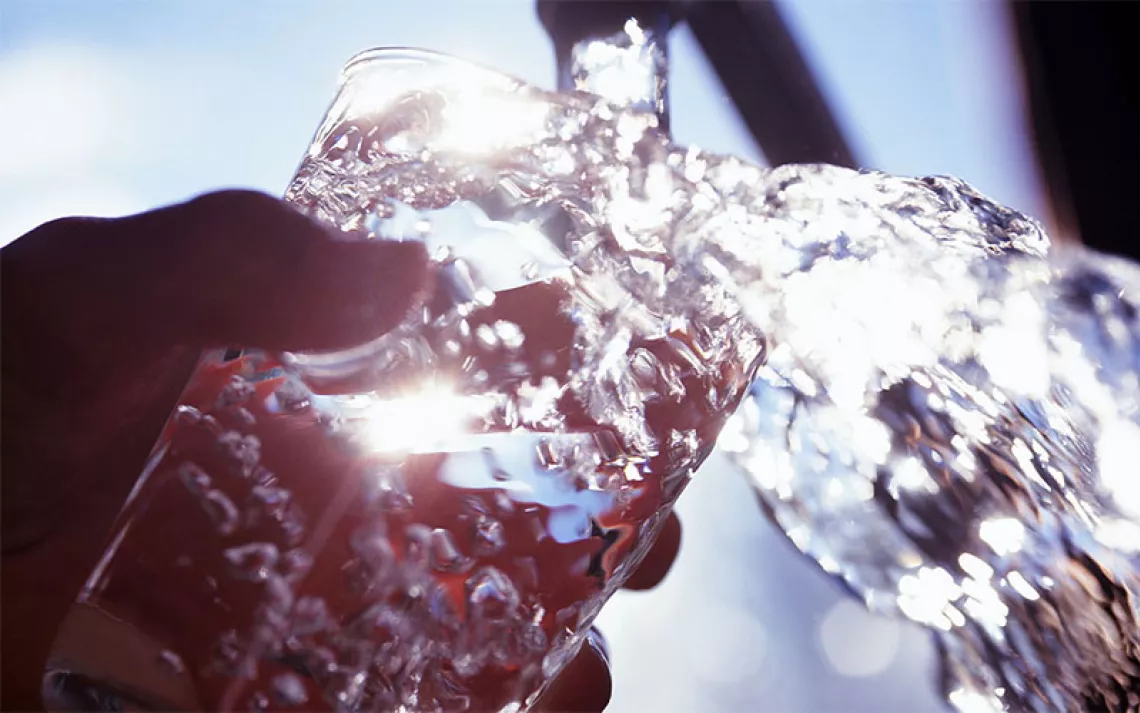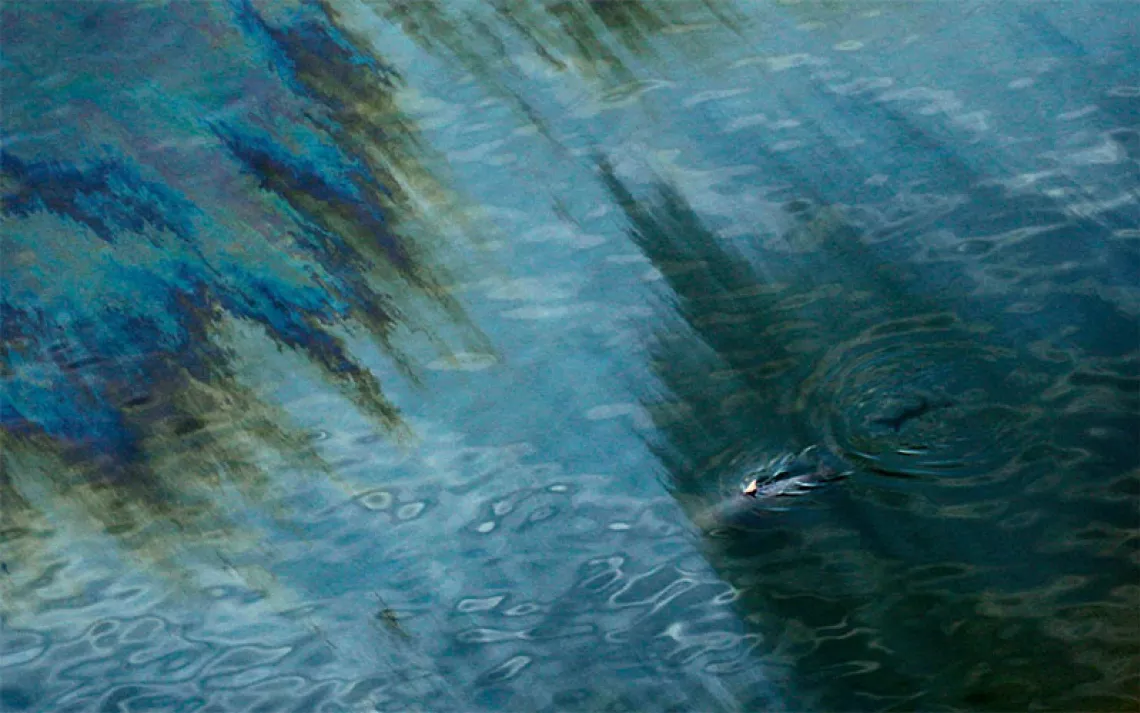Should Chicago Dye Its River Green for St. Patrick’s Day?
The dye is considered environmentally friendly, but some groups say the river shouldn’t be altered

Members of the Plumbers Union Local 130 dye the Chicago River green ahead of St. Patrick's Day in 2022. | Photo by Tyler Pasciak LaRiviere/Chicago Sun-Times via AP
For just a few hours each year, the St. Patrick’s Day celebrations on the streets of Chicago spill over into the river. A small section of the Chicago River flowing near the Michigan Avenue Bridge turns from its typical muted blue-green to a neon leprechaun green. In a city that prides itself on its Irish heritage, the tradition is well loved by holiday revelers. This brief, altered hue is not naturally occurring, but instead stems from a dye that has seen various formulations and been the subject of environmentalists’ concerns over the years. The City of Chicago claims the dye it uses today now poses no ecosystem risks, but some organizations still question whether the event sets an appropriate culture of respect for the body of water running prominently through the city’s downtown.
The “greening” of the Chicago River is a tradition that goes back to 1962, and was actually born from an effort to clean up the waterway at its most polluted. According to Chicago's St. Patrick's Day Parade website, Stephen Bailey, business manager of the local plumber union, came across a plumber whose normally white overalls were stained green. That plumber was part of a team pouring small amounts of green dye into the sewers to detect where waste was leaking into the river. It hosted only about seven species of fish by the 1960s. Earlier in its history, the waterway had also been a dumping ground for the city’s slaughterhouses. At times, there were so many carcasses decomposing in the Chicago River that it bubbled in places.
The encounter with the overalled plumber inspired Bailey, childhood friend of then-mayor Richard J. Daley and chairman of this nascent St. Patrick's Day Parade, to have the Chicago Journeymen Plumbers Local 130 union dump this tracer dye into the Chicago River as part of the holiday celebration. The plumbers’ union still manages the dyeing today.
“When [this event] started, it was a way to, for a short period of time around a major holiday, convert something that was basically an eyesore into a decoration for Chicago’s downtown,” says Jack Darin, director of the Sierra Club’s Illinois Chapter.
In the original stunt, the river stayed green for a week, while the dye used today lasts only about four hours. The amount and formula of the dye used in the celebration has changed over the years. Originally the plumbers used an oil-based fluorescein dye. Environmentalists argued it was toxic to the river, and the city switched to a more environmentally friendly, plant-based dye that is orange until turning green upon contact with water.
Chicago isn’t the only city that turns its waters green for St. Patrick’s Day. Tampa, Florida, dyes the Hillsborough River for its own holiday celebration. According to Liz Hall, a communications and public relations specialist with the City of Tampa, the city uses a green-yellow tracer dye, which is typically used to track the flow of liquids, often in an attempt to protect the environment (as with the origin of Chicago’s dye).
Tampa’s St. Patrick’s Day dye, which a company called Bright Dyes produces, meets minimum health requirements for chemicals that are added to drinking water, according to National Sanitation Foundation standards. Hall says that the Hillsborough County Environmental Protection Commission inspected the safety data sheet, and there were no objections to using it to dye the river green. To date, the city hasn’t reported any negative effects from the event.
The City of Chicago doesn’t release the ingredients or the type of dye used in its celebration, and there is also no permit for its St. Patrick’s Day event, says Darin. In the past, the Illinois Chapter has recommended to the EPA that the agency require one. In a statement to Sierra, the Illinois EPA stated that while a permit has not been issued for this event, the agency did review the information and safety data for the dye and concluded that there is no toxic effect.

Sign up to receive Sierra News & Views
Get articles like this one sent directly to your inbox weekly.
With this action you affirm you want to receive Sierra Club communications and may vote on policy designated by the Sierra Club Board.
In a 2021 letter to the editor published in the Chicago Sun Times, the Sierra Club Illinois Chapter, Friends of the Chicago River, and Openlands, a conservation nonprofit in the Chicago area, argue that even if the dye isn’t environmentally harmful, the city needs to rethink how it chooses to protect and interact with the river, especially as a signal to residents.
The official “greening” event downtown has inspired rogue dyers in past years. In recent years, revelers have snuck green dye into the north branch of the river three times without the city’s permission. Despite patrolling the area in March 2022, conservation police failed to detect the people responsible for illegally dumping green dye into a different section of river.
In the days since the original toxic formula for “greening” the Chicago River and the 1972 passage of the Clean Water Act, the waterway has become a source of recreation and economic activity. The plumbers union that still dyes the river each year can also claim a large part of the credit for this turnaround, says Darin. They did much of the work on the clean water infrastructure surrounding the river and continue doing work that keeps the city's water supply clean.
“We totally understand the origins of the practice and the fact that Chicago will always be a proud Irish town,” he says. But after so much intentional work to clean up the river, dyeing it an unnatural green “does seem increasingly anachronistic now that we’re able to celebrate the river with its natural color most other days.”
 The Magazine of The Sierra Club
The Magazine of The Sierra Club



